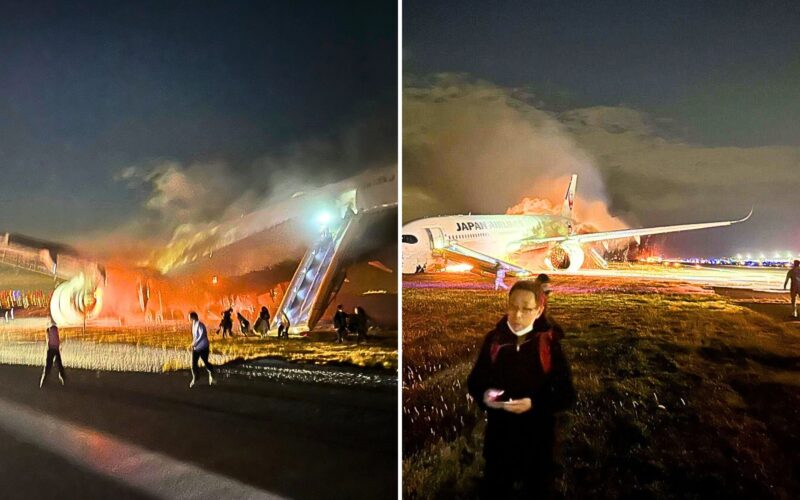When Japan Airlines flight JL 516 collided with a Coast Guard aircraft at Haneda Airport’s (HND) runway while landing on January 2, 2023, the fiery explosion on impact appeared catastrophic and most likely fatal.
The collision claimed five lives from the Japanese Coast Guard’s DHC-8-315Q, but all 367 passengers and 12 crew members of Japan Airlines’ Airbus A350 managed to evacuate safely.
The miraculous evacuation from the burning A350 is being credited to the efficient crew, who, despite the chaotic and terrifying conditions, managed to evacuate all 379 people, including eight children under the age of two.
In a report by The Guardian, Japan Airlines claims that all 367 passengers and 12 crew disembarked in under 20 minutes.
Here are factors that could have contributed to a safe and successful evacuation.
The 90-second rule of evacuation
The International Civil Aviation Organization (ICAO) and the Federal Aviation Administration (FAA) require all aircraft manufacturers to demonstrate that all planes can be fully evacuated in 90 seconds.
According to aviation safety site SKYbrary, 90 seconds has been established as the maximum evacuation time because tests have shown that, in a post crash fire, conditions conducive to flashover are unlikely to occur within that time span.
A flashover is the near-simultaneous ignition of most of the directly exposed combustible material in an enclosed area. It’s the instance of a fire spreading very rapidly across a gap due to intense heat.
SKYbrary also explained that the experience of actual evacuations, especially unexpected ones from full aircraft where an abnormal situation occurs suddenly at or soon after landing, indicates that evacuation times usually exceed durations demonstrated for certification purposes.
According to a report by Channel News Asia, all of the 367 passengers and 12 crew members of JL 516 exited in just 90 seconds.
Working against the elements and quick thinking
The crew deserves huge acclaim for their efficient and timely evacuation, especially as they were faced with two big hurdles to a smooth evacuation.
First, the fire and impact of the accident damaged the aircraft’s PA system, so the crew had to use megaphones and their own voices to instruct and herd passengers to safety.
Second, when the A350 managed to stop at the runway, the aircraft’s right engine still exhibited sparks with fire growing in the right aft fuselage. AVGeekery credits the crew for making the right decision to deploy emergency slides at the front exits and left rear door.
Calm passengers
As much as the crew are being heralded for saving the lives of everyone onboard JL 516, credit also needs to go to the passengers, who remained calm and composed for much of the time.
A Fly Guy’s Cabin Crew Lounge, a Facebook group for airline and aviation professionals with over 1.3 million members, shared a video clip of what transpired inside the cabin just before evacuation, followed by a clip during evacuation.
It’s noteworthy that passengers remained exceptionally calm in the face of danger. Most of the passengers can see that the aircraft is engulfed in flames, yet no one panicked. Most importantly, they listened to the flight attendants’ instructions and left their belongings in the aircraft.
The Facebook post was captioned with the following:
“Notice how calm the passengers are, even with a fire raging outside. They patiently await instructions from the crew, who are clearly alert and ready for action.
For individuals unfamiliar with evacuation procedures, flight attendants initiate an immediate evacuation only in catastrophic situations, such as water landings or when the aircraft is broken into pieces.
In the video, the crew is likely awaiting instructions from the pilots, who are occupied with critical tasks like turning off engines and identifying usable exits. It is crucial to wait for these instructions to avoid potential dangers, such as passengers using exits near engines or into a fire.
While the flight attendants are aware of the fire, they adhere to the protocol, waiting for evacuation commands. This is precisely what we expect passengers to do during such moments – remain calm, refrain from grabbing bags, and avoid rushing the doors and yelling to open them.
Crew train yearly for this very situation. Trust their training.”
An in-flight safety video that works
Another element that played in the efficient, ‘textbook’ evacuation that was performed by the crew, and followed by passengers, was Japan Airlines’ in-flight safety video.
While most airlines nowadays focus on tourism, entertainment factor, and using the videos as a marketing strategy, Japan Airlines adhered to the traditional format of its in-flight safety video, using graphic animation to demonstrate what would likely happen if passengers brought personal items during an evacuation.
This is likely to have deterred passengers from insisting on getting their belongings and proceeding to evacuate quickly instead.
In an interview with Channel News Asia, Assistant professor of aviation and integrated systems engineering Shawn Pruchnicki from Ohio State University said that the biggest hindrance to the 90-second rule of evacuation are passengers insisting on taking their belongings.
With JL 516 being evacuated in 90 seconds, Pruchnicki said that it is likely that the passengers followed correct procedures.

